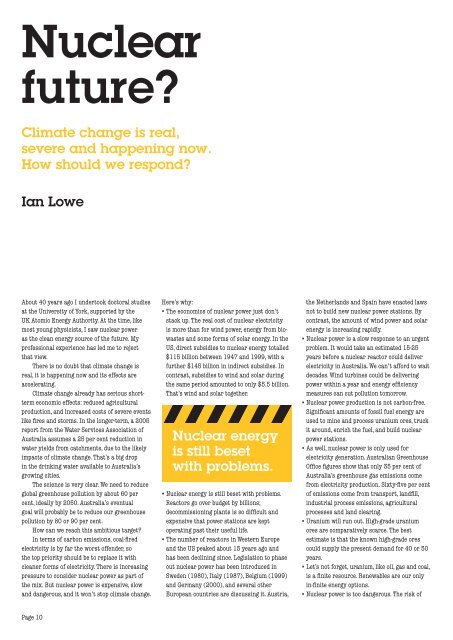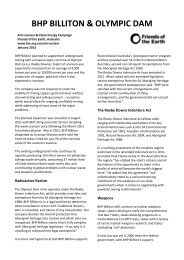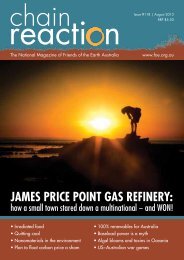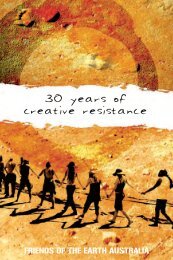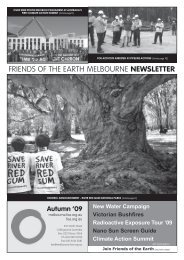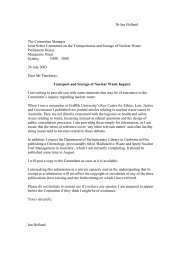Yellowcake Country? - Friends of the Earth Australia
Yellowcake Country? - Friends of the Earth Australia
Yellowcake Country? - Friends of the Earth Australia
You also want an ePaper? Increase the reach of your titles
YUMPU automatically turns print PDFs into web optimized ePapers that Google loves.
Nuclear<br />
future<br />
Climate change is real,<br />
severe and happening now.<br />
How should we respond<br />
Ian Lowe<br />
About 40 years ago I undertook doctoral studies<br />
at <strong>the</strong> University <strong>of</strong> York, supported by <strong>the</strong><br />
UK Atomic Energy Authority. At <strong>the</strong> time, like<br />
most young physicists, I saw nuclear power<br />
as <strong>the</strong> clean energy source <strong>of</strong> <strong>the</strong> future. My<br />
pr<strong>of</strong>essional experience has led me to reject<br />
that view.<br />
There is no doubt that climate change is<br />
real, it is happening now and its effects are<br />
accelerating.<br />
Climate change already has serious shortterm<br />
economic effects: reduced agricultural<br />
production, and increased costs <strong>of</strong> severe events<br />
like fires and storms. In <strong>the</strong> longer-term, a 2005<br />
report from <strong>the</strong> Water Services Association <strong>of</strong><br />
<strong>Australia</strong> assumes a 25 per cent reduction in<br />
water yields from catchments, due to <strong>the</strong> likely<br />
impacts <strong>of</strong> climate change. That’s a big drop<br />
in <strong>the</strong> drinking water available to <strong>Australia</strong>’s<br />
growing cities.<br />
The science is very clear. We need to reduce<br />
global greenhouse pollution by about 60 per<br />
cent, ideally by 2050. <strong>Australia</strong>’s eventual<br />
goal will probably be to reduce our greenhouse<br />
pollution by 80 or 90 per cent.<br />
How can we reach this ambitious target<br />
In terms <strong>of</strong> carbon emissions, coal-fired<br />
electricity is by far <strong>the</strong> worst <strong>of</strong>fender, so<br />
<strong>the</strong> top priority should be to replace it with<br />
cleaner forms <strong>of</strong> electricity. There is increasing<br />
pressure to consider nuclear power as part <strong>of</strong><br />
<strong>the</strong> mix. But nuclear power is expensive, slow<br />
and dangerous, and it won’t stop climate change.<br />
Here’s why:<br />
• The economics <strong>of</strong> nuclear power just don’t<br />
stack up. The real cost <strong>of</strong> nuclear electricity<br />
is more than for wind power, energy from biowastes<br />
and some forms <strong>of</strong> solar energy. In <strong>the</strong><br />
US, direct subsidies to nuclear energy totalled<br />
$115 billion between 1947 and 1999, with a<br />
fur<strong>the</strong>r $145 billion in indirect subsidies. In<br />
contrast, subsidies to wind and solar during<br />
<strong>the</strong> same period amounted to only $5.5 billion.<br />
That’s wind and solar toge<strong>the</strong>r.<br />
Nuclear energy<br />
is still beset<br />
with problems.<br />
• Nuclear energy is still beset with problems.<br />
Reactors go over budget by billions;<br />
decommissioning plants is so difficult and<br />
expensive that power stations are kept<br />
operating past <strong>the</strong>ir useful life.<br />
• The number <strong>of</strong> reactors in Western Europe<br />
and <strong>the</strong> US peaked about 15 years ago and<br />
has been declining since. Legislation to phase<br />
out nuclear power has been introduced in<br />
Sweden (1980), Italy (1987), Belgium (1999)<br />
and Germany (2000), and several o<strong>the</strong>r<br />
European countries are discussing it. Austria,<br />
<strong>the</strong> Ne<strong>the</strong>rlands and Spain have enacted laws<br />
not to build new nuclear power stations. By<br />
contrast, <strong>the</strong> amount <strong>of</strong> wind power and solar<br />
energy is increasing rapidly.<br />
• Nuclear power is a slow response to an urgent<br />
problem. It would take an estimated 15-25<br />
years before a nuclear reactor could deliver<br />
electricity in <strong>Australia</strong>. We can’t afford to wait<br />
decades. Wind turbines could be delivering<br />
power within a year and energy efficiency<br />
measures can cut pollution tomorrow.<br />
• Nuclear power production is not carbon-free.<br />
Significant amounts <strong>of</strong> fossil fuel energy are<br />
used to mine and process uranium ores, truck<br />
it around, enrich <strong>the</strong> fuel, and build nuclear<br />
power stations.<br />
• As well, nuclear power is only used for<br />
electricity generation. <strong>Australia</strong>n Greenhouse<br />
Office figures show that only 35 per cent <strong>of</strong><br />
<strong>Australia</strong>’s greenhouse gas emissions come<br />
from electricity production. Sixty-five per cent<br />
<strong>of</strong> emissions come from transport, landfill,<br />
industrial process emissions, agricultural<br />
processes and land clearing.<br />
• Uranium will run out. High-grade uranium<br />
ores are comparatively scarce. The best<br />
estimate is that <strong>the</strong> known high-grade ores<br />
could supply <strong>the</strong> present demand for 40 or 50<br />
years.<br />
• Let’s not forget, uranium, like oil, gas and coal,<br />
is a finite resource. Renewables are our only<br />
in-finite energy options.<br />
• Nuclear power is too dangerous. The risk <strong>of</strong><br />
Page 10


